Depth | Author | TaxDAO& Precision Fund Services
As a globally renowned offshore financial center, the Cayman Islands is also the largest offshore fund establishment location in the world, with over 85% of offshore funds registered in the Cayman Islands. Additionally, the Cayman Islands provides very favorable tax policies, where funds in the Cayman Islands are not required to pay income tax, capital gains tax, dividend tax, etc. It has also signed tax information exchange agreements with countries such as the United Kingdom, the United States, and Australia. According to data from the Cayman Islands Monetary Authority (CIMA), as of the end of 2020, there were a total of 26,351 regulated open-ended funds and 9,857 regulated closed-ended funds in the Cayman Islands, with the total assets of these funds exceeding two trillion US dollars. There are countless exempted regulated funds established in the Cayman Islands.
Establishing funds in the Cayman Islands has become an important method for cross-border investment, and setting up private equity funds for digital asset investment is also gradually favored by Web3 investors. This article mainly introduces three typical structures for setting up offshore funds in the Cayman Islands for investment, and analyzes the tax risks designed under the LP (limited partnership) structure.
1 Three Typical Organizational Forms of Cayman Funds
There are several typical organizational forms for exempted regulated funds in the Cayman Islands, including Exempted Company (EC) and Exempted Limited Partnership (ELP). This article first selects three typical fund structures for analysis.
1.1 Stand-Alone Fund Structure
In a stand-alone fund, there are two entities, with the fund entity usually established in the form of an exempted limited partnership, and the investment team subscribing to the participating shares of the fund (with dividend rights but no voting rights). At the same time, the investment team establishes a fund management company in the British Virgin Islands (BVI) as the managing shareholder of the fund (not participating in dividends but having the right to vote at shareholder meetings). The rights for the daily decision-making and operation of the fund are held by the fund board of directors appointed by the investment team.
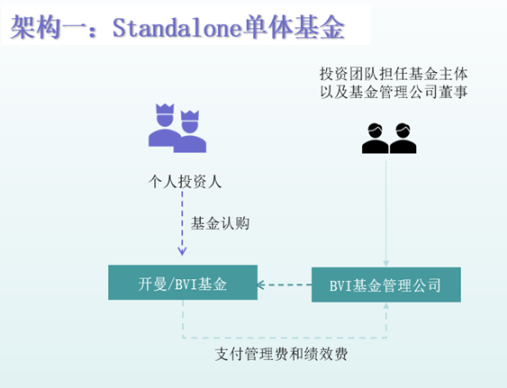
1.2 Segregated Portfolio Company (SPC) Structure
The Segregated Portfolio Company (SPC) is a special case within the EC structure and is a unique form under Cayman law. In the SPC structure, the SPC, as an exempted entity, can establish up to 25 independent investment portfolios (Segregated Portfolios, SP), and the assets and liabilities between these investment portfolios are completely independent. Operating multiple different funds under the SPC has a similar effect to establishing multiple stand-alone funds, making the SPC more cost-effective. The specific SPC structure is shown in the following figure.
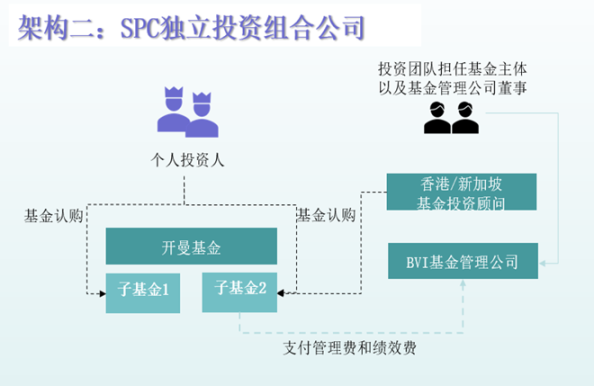
1.3 Exempted Limited Partnership (ELP) Structure
The ELP structure is mainly divided into three steps. First, investors establish a GP (general partner) company in the Cayman Islands/BVI as the general partner of the ELP. Second, individual investors, the GP company established in the first step, and the GP team jointly hold the investment entity SLP (limited partner) to form the ELP fund entity. Then, the ELP establishes an SPV (special purpose vehicle) to conduct investment business. The GP has management and control rights over the ELP fund affairs, responsible for the operation, management, control, and conduct of the fund business.
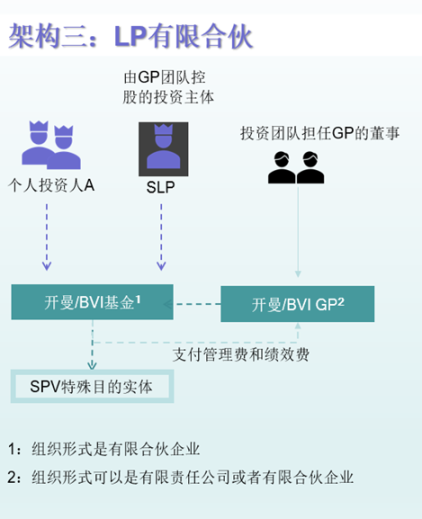
The SPV under the fund entity refers to a subsidiary company or partnership established by the fund entity to invest in a specific project, usually in the form of an ELP, with the fund entity as the general partner or limited partner, and the project party as the limited partner or general partner. The ELP structure can bring the following benefits:
Utilize the favorable tax policies of the Cayman Islands to avoid double taxation and foreign exchange controls.
Flexibly design the investment strategy, profit distribution, exit mechanism, etc., for different projects based on their characteristics and needs, and protect the interests of investors and project parties.
Similar to SPC, ELP can also separate the risks and returns of different projects, avoid mutual influence, and improve transparency and efficiency.
2 Choice of SPV Location under ELP Structure
Under the ELP structure, the fund entity uses the SPV to invest in downstream enterprises, and the SPV can independently liquidate, safeguard shareholder rights, and achieve risk isolation. In practice, the choice of SPV location generally falls on Hong Kong or Singapore, which is convenient for conducting financial activities and can also enjoy the low tax rate advantages of both places. This article analyzes the impact of four factors—interest, dividends, property income, and stamp duty—on the choice of SPV location, as shown in the table below.
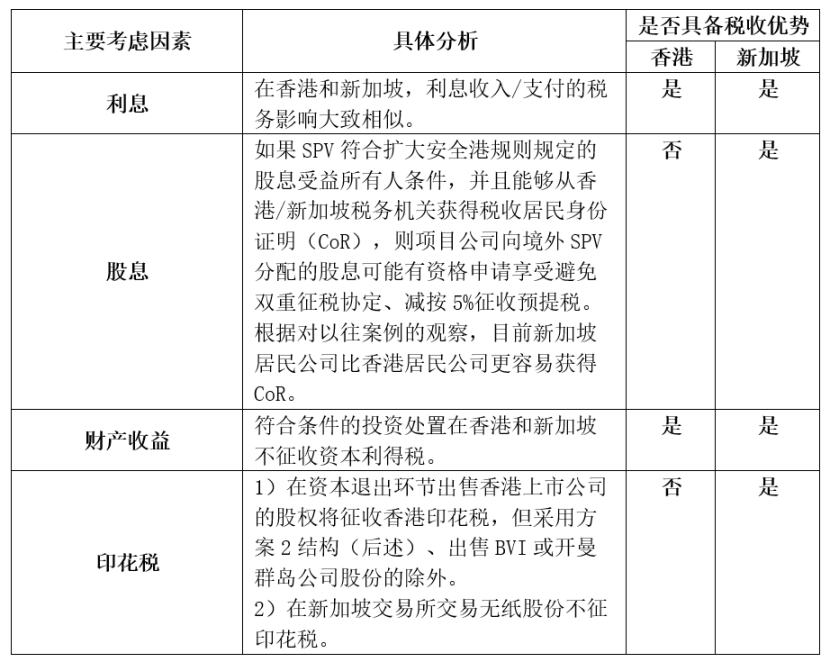
It can be seen that in terms of dividends and stamp duty, Singapore as the location for the SPV has more cost advantages compared to Hong Kong: Singapore's dividend tax exemption for SPV is more lenient, and its stamp duty regulations are also simpler and lower in cost. However, transaction costs are just one aspect to consider when choosing the location for the SPV, and the specific choice of location should be judged based on the policies of the two places, as well as the characteristics and needs of different industries and structures.
3 Three Stages of Investment under ELP Structure and Analysis of Tax Risks
3.1 Taxation in the Investment Stage
The investment stage mainly involves three steps: establishing overseas structures, setting up domestic asset management companies and wholly foreign-owned enterprises (WOFE), and acquiring project companies. There are relatively few tax issues involved in this stage.
Establishing overseas structures can be roughly divided into the following two schemes: Scheme one is a simplified Cayman structure, where a holding company is established in the Cayman Islands, and then this company invests in overseas or domestic project companies or special purpose entities. Scheme two is the BVI/Cayman—Cayman structure, where a holding company is established in the Cayman Islands, and a subsidiary holding company is established in the British Virgin Islands (BVI) or the Cayman Islands, and then this subsidiary holding company invests in overseas or domestic project companies or special purpose entities.
The advantage of scheme one is its simple structure, low cost, and easy management. It only requires the registration and maintenance of a holding company in the Cayman Islands, without the need to register and maintain another holding company in the BVI, while also being able to enjoy tax benefits in the Cayman Islands. However, its disadvantages are higher risk, poor confidentiality, and lower flexibility. If the Cayman holding company directly invests in projects in other countries, it may be subject to restrictions or regulations of other countries' laws. If the Cayman holding company goes public, it may expose information about its investors and investment projects. If the Cayman holding company needs to change its investment strategy or exit projects, there are corresponding additional costs.
The advantage of scheme two is lower risk, better confidentiality, and higher flexibility. By establishing a subsidiary holding company in the BVI or Cayman, it can isolate the risks between the Cayman holding company and the investment projects; this structure also provides higher confidentiality, without the need to disclose information about its directors, shareholders, beneficial owners, etc. By establishing a subsidiary holding company in the BVI, it can flexibly design the investment strategy, profit distribution, exit mechanism, etc., for different projects based on their characteristics and needs, and protect the interests of investors and project parties. Its disadvantages are a complex structure, high cost, and management complexity. It requires the registration and maintenance of two holding companies in two regions, increasing compliance risks and management difficulties.
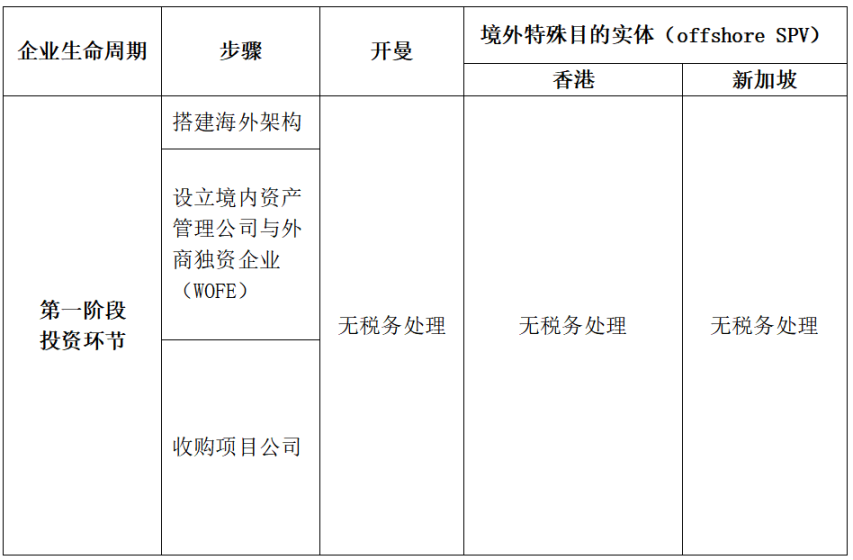
3.2 Taxation in the Production and Operation Stage
Production and operation are the direct sources of profit and the main channel for controlling tax risks. Overall, Hong Kong's tax policies are more straightforward and result in lower tax burdens for businesses. Singapore has higher tax rates on certain taxable items, such as bank interest income and cross-border interest payments. The tax regulations for different taxable items in Hong Kong and Singapore are shown in the table below.
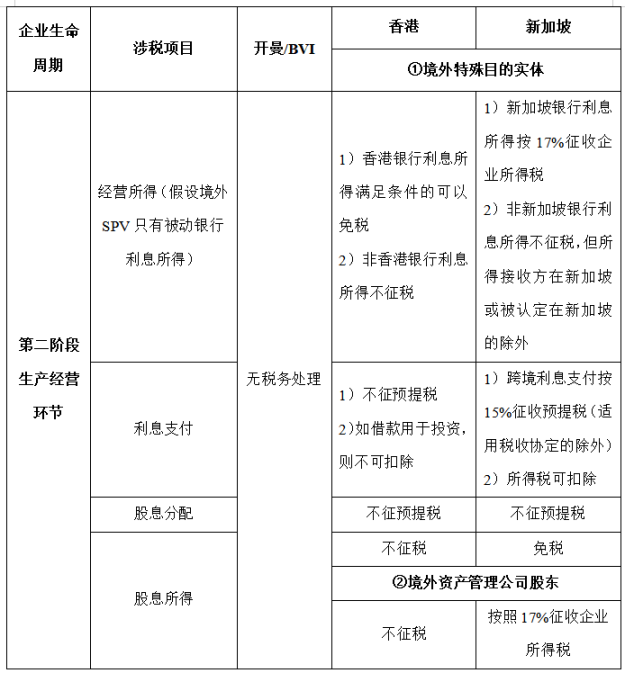
3.3 Taxation in the Capital Exit Stage
In the capital exit stage, Scheme 1 and Scheme 2 face different tax issues. Overall, there is not much difference in tax between the two exit schemes, except that Scheme 2 has an additional layer of a BVI subsidiary holding company, which does not have a significant impact on taxation.
As shown in the table below, in the Cayman Islands, there is no need to pay any taxes or fees for disposing of a holding company or a special purpose entity. When exiting investments in Hong Kong, only the disposal of a listed Cayman holding company and SPV requires payment of stamp duty, with a low rate of 0.1% borne by each party. Other types of disposals do not require payment of taxes or fees. When exiting investments in Singapore, only the disposal of SPV requires payment of stamp duty, with the buyer bearing 0.2%. Other types of disposals do not require payment of taxes or fees.
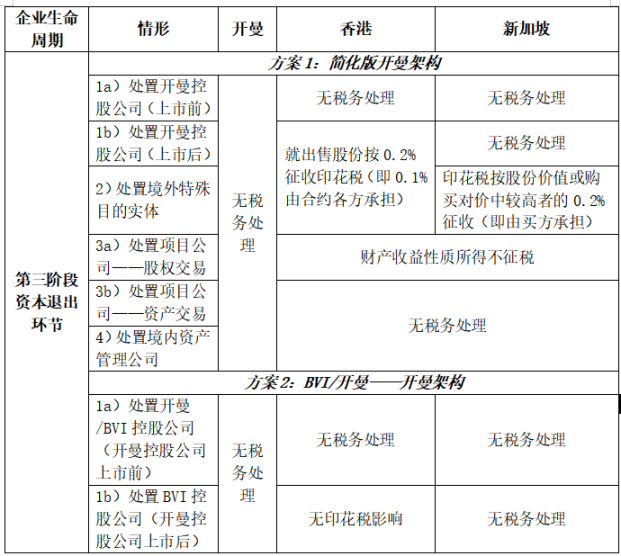
4 Risk Expansion and Discussion of Cayman Funds
4.1 Risk of Separation of Actual Management Location and Registration Location
The actual management institutions of offshore funds are often established in Hong Kong or Singapore. Due to the inconsistency between the location of the management institution and the registration location, corresponding tax risks may arise. Considering that the Cayman Islands, Hong Kong, and Singapore have not signed double taxation agreements (DTAs), the actual tax situation will be more complex.
The main tax risk for offshore funds in the Cayman Islands is that their actual management institution may be considered a tax resident or have taxable income in the location, leading to the need to pay income tax or other taxes in that area. Risk management mainly depends on the tax laws of the actual management institution's location, which may use different criteria and taxation principles. Therefore, when choosing the location of the actual management institution, offshore funds should fully understand and compare the tax laws of these locations to choose the most favorable one or take measures to avoid or reduce tax risks.
Under Singapore's tax laws, whether a company is a tax resident of Singapore mainly depends on whether the company is controlled and managed in Singapore. Control and management refer to the location of the highest decision-making body of the company, usually the location of the company's board meetings. Therefore, if the actual management institution of a Cayman offshore fund is in Singapore, it may be considered as being controlled and managed in Singapore, and thus become a tax resident of Singapore. Tax residents of Singapore are required to pay tax on global income (at a rate of 17%).
Under Hong Kong's tax laws, whether a company needs to pay profits tax in Hong Kong mainly depends on whether the company's profits are derived from trade, business, or operations in Hong Kong, i.e., whether the company's profits have a substantial connection to Hong Kong. Therefore, if the actual management institution of an offshore fund is in Hong Kong, its investment income may also be deemed to be "sourced from Hong Kong," and thus subject to profits tax in Hong Kong (at a rate of 16.5%).
In addition to tax risks, regulatory risks and legal risks are also issues to consider during the investment process. Firstly, if the financial regulatory authorities in Hong Kong or Singapore determine that the offshore fund is engaged in financial services activities in the area, the fund entity may be required to comply with regional financial regulatory laws, including but not limited to obtaining the appropriate licenses, disclosing relevant information, and accepting inspections by regulatory authorities. Secondly, the actual management institution needs to comply with relevant laws in the area and may also have to deal with litigation or arbitration under local legal frameworks, which requires addressing jurisdiction and governing law issues.
4.2 Risks of the Cayman Economic Substance Law for Fund Investments
The Cayman Economic Substance Law is a legal risk that cannot be ignored for investors and managers establishing funds in the Cayman Islands. Failure to meet economic substance requirements may affect the tax status of the fund, increase additional disclosure obligations, and even lead to the cancellation of the fund. Therefore, investors and managers need to reasonably choose and design the structure and operation of the fund based on their specific circumstances. They also need to closely monitor the further interpretation and implementation of the Economic Substance Law by the Cayman government and tax authorities, and adjust and optimize their fund strategies in a timely manner.
While setting up funds in the Cayman Islands for digital asset investments has potential and prospects, it also faces many challenges and risks. Therefore, investors and managers need to fully understand the characteristics and patterns of digital assets, and properly allocate and manage their digital asset portfolios to achieve long-term stable investment returns.
This article only analyzed and compared three fund structures for digital asset investments in the Cayman Islands from a tax perspective. In practice, investors and managers also need to consider various factors based on their specific goals and needs to choose the most suitable fund structure.
Reference
[1] Zhang, Z., Wang, W., & Jiang, J. (2023). Introduction to Typical Fund Structures and Digital Asset Funds.
免责声明:本文章仅代表作者个人观点,不代表本平台的立场和观点。本文章仅供信息分享,不构成对任何人的任何投资建议。用户与作者之间的任何争议,与本平台无关。如网页中刊载的文章或图片涉及侵权,请提供相关的权利证明和身份证明发送邮件到support@aicoin.com,本平台相关工作人员将会进行核查。




